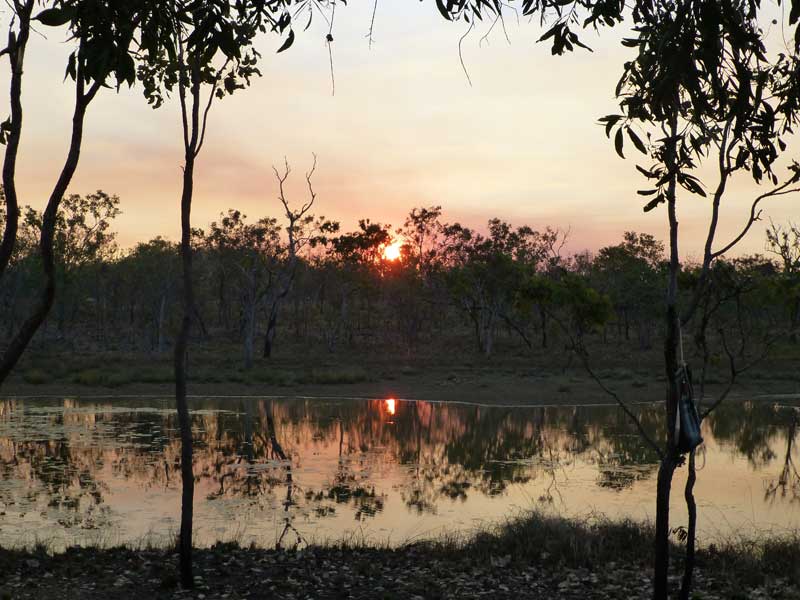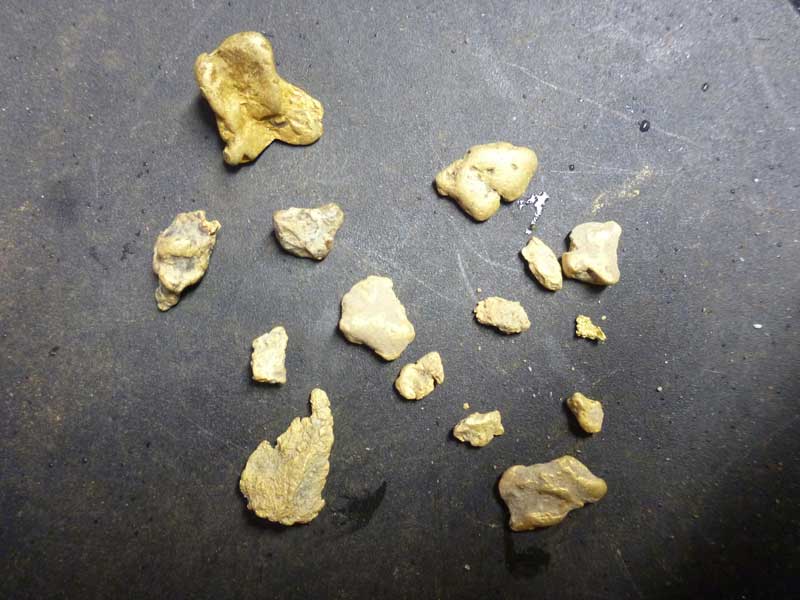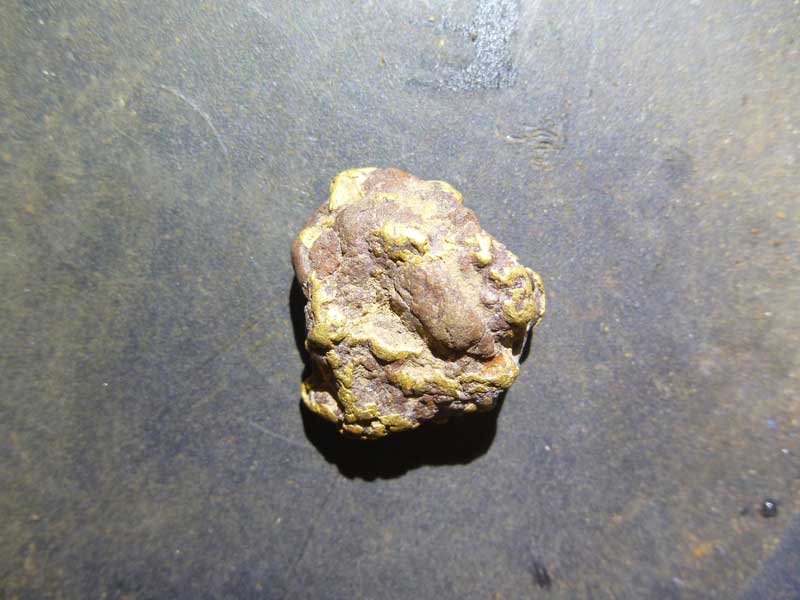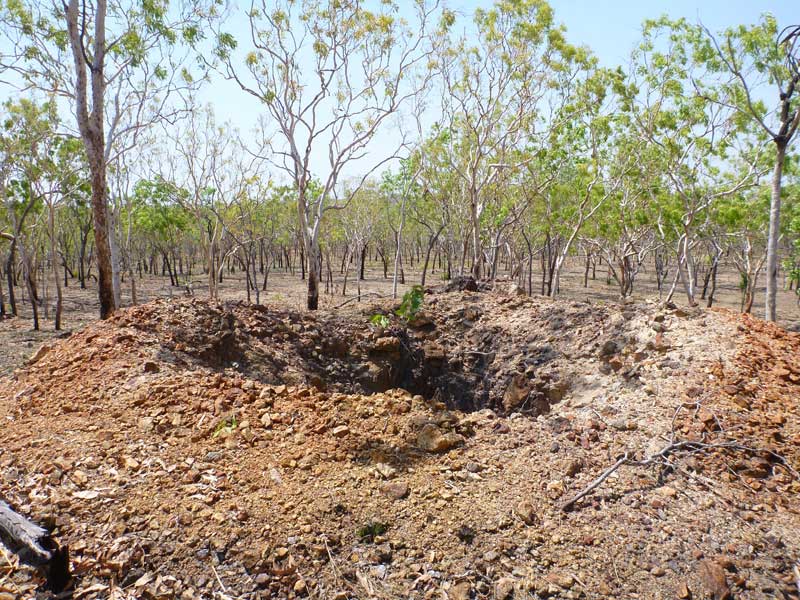Visitors page
Mr David Langley
September 2013
"There were over 100 visitors to the Margaret Diggings this dry season but there were no big finds. The biggest Gold/ Quartz specimen found weighed 48 grams and it was a typical very rich (30% Au.) Margaret specimen and it would have about 16 grams of gold in it. It was worn smooth and had beautiful coarse, water-worn nuggety gold shining out of it. There were also a couple of nice 5 gram nuggets and a lot of smaller ones from 2 grams down to half a gram. Most visitors did not ask the Pastoral Lease holder for permission. Please do so on future visits. Do not shoot in the area. You might kill someone !
There are still hundreds of ounces of gold in the Margaret diggings gravel that was not worked by the old diggers in 1880. Many years ago I found a virgin patch of gravel at the North end of the diggings. It is about 100 metres in length and 30 metres wide. My first find on the patch was a 4.5 oz Au/Qtz specimen and the next was a 2.5 oz one and a couple of ounces of small nuggets. It has produced a lot of good nuggets and specimens for various people since then. Two years ago our well known local prospector “Wally" found another nuggety patch of ground about the same size, further to the north. He detected a large specimen and a couple of nuggets there. There are other places where the rich nuggety bottom gravel is too deep for metal detectors. Fossickers are allowed to dig to one metre but I didn’t see anyone digging a pit.
Panning the Margaret Diggings gravel usually gives a speck or two of gold or a small nugget if you are lucky and there would still be big nuggets in the deeper ground that wasn’t worked by the Diggers of 1880. The Margaret River itself is carrying fine and coarse gold in its gravel for kilometres downstream. It is agood place to practice panning and it has fish and yabbies and a few fresh water crocodiles in its permanent waterholes and many nice places to camp.
The good news is that there are numerous creeks in the Top End that have gold in them but they have no known source. Most of the world’s goldfields were found with a pick and shovel and panning dish. Metal detectors have also found a number of gold reefs in recent years. We need to find new goldfields instead of flogging the old ones to death. The occasionalnice nugget still gets found on the old fields but it is getting much harder. We need more panners to find new reefs and patches of nuggets. I recently flagged a 4WD track to the source of the gold at the South end of the Margaret Diggings on my E.L.25288. I believe that the source is under the Laterite near the start of the high grade Manganese reef that I found. I recently pegged a 20 Ha Mineral Lease over it. None of the creeks upstream to the south of the laterite carry any gold. Visitors are welcome on the Lease, but please let me know what you find and where you found it.
There are a few creeks near Darwin where you can practice your panning. The nearest one is probably Mitchell Creek East of Roseberry in Palmerston. I went to pan the creek about twenty years ago but there was no water, so I took a fine soil sample from the creek bottom and had it assayed. It gave a result of 40 ppb Au. It was the highest stream sediment assay result for gold that I ever took. I was working as a subcontract Surveyor/Prospector for Carpentaria Gold (M.I.M.) at the time and I told them about it. They then sent out their own prospector, Henry Robertson, who prospected the area thoroughly and found a 5 gm/ton gold reef on the South side of the road cutting on the East side of the Elizabeth River bridge. The area N.W of the Garbage dump might also be worth a look. There is some interesting looking quartz laying around there. Henry found more gold reefs in the Top End than any Geologist or Prospector ever did. He was trained by Geologist Peter Simpson who was the finder of the big “Tom’s Gully" gold reef near Mt Bundey. Henry is an ex Ringer, Fencer, Boreman and “Jack of all Trades." My favorite reef that Henry found was the “William" reef at Marrakai. It was 30m long, 30cm wide at its centre and it had a steady grade of 2 ozs/ton Gold. Coarse visible gold was visible in the ore. I was one of numerous people that walked over it without noticing it ! The original holder of the claim also missed it. Several years later I found two more shorter reefs nearby that also assayed 2 oz/ton gold. We later mined all three reefs. Nobody finds it all.
There are several places near Darwin where you can pan alluvial gold. The Blackmore River "Tumbling Waters" carries a little gold which comes from the Peel Creek. The source of the gold in the Peel creek is upstream from Spencer Road. It is a small tributary that enters into Peel creek from the west, a bit to the south of the “Hoods Duck Ponds." I panned 14 nice specks of gold in my first dishful from this creek. The source is a quartz reef near the end of a ridge a couple of hundred metres upstream. Most of the creeks that drain the western edge of the nearby Archaen Granite that hosted the Rum Jungle Uranium also carry gold. The Rum Jungle granite is a similar age to the Mt Bundey granite. Both of these granites are radioactive and they make my Scintolometer squeal. Perhaps I should check the radiation level of the Mt Bundey tiles on the floor of the main hall of Parliament House?
Many creeks in the N.T. carry gold. The source of the gold in most of these creeks has never been discovered. So get your pan and 5 mm sieve and pick and shovel etc and follow the gold to the source. Then get out your detector and/or sample bags and hopefully find yourself a goldmine.
The source of the first gold found in the N.T. in 1872 still hasn’t been found. That first Au/qtz specimen was found at the headwaters of the Shackle Creek upstream from the Grove Hill road by workers digging post holes for the Overland Telegraph line. The Shackle Creek is the creek coming from the West before you get to the Golden Dyke Pit at the top of the hill. The creek carries alluvial gold along all of its length. The source of the gold is in the hills close to the granite contact about one km (crow) S.W of the Golden Dyke pit, but it isn’t outcropping! I panned gold near the source about ten years ago and then detected several small nuggets there. A mate of mine then found a couple more specimens and then a beautiful solid 22 gram nugget that looks like a Rabbit. It was about 5 metres from where the source is on the Nth end of an anticline. The area is now covered by a one block Exploration License held by Crocodile Gold. Perhaps they are thinking of opening up the “Golden Dyke" and “Langley’s" reefs again? The water in the Langley’s Pit is not acidic and there are fish and yabbies and freshwater crocs living in it. Kangaroos and other wildlife also use the water." I would rather see this E.L. block used as a Public Fossicking area."
Fred’s Holiday
August 2013
I was looking forward to spending a couple of weeks annual leave in and around the Margaret Diggings and Springhill South areas camping and showing the kids some of the Top End’s mining history in this area. I also intended doing a bit of detecting for gold.
Before heading off I spent a bit of time checking out the new ‘Fossicking in the Northern Territory’ website to make sure that I did not need to get consent or notify anyone that I intended to fossick on their land or mineral title.
As it turns out it was a good thing that I checked as I needed to get consent to enter the two proposed fossicking areas and I also needed to notify the pastoralist!
With that sorted I headed off with the wife and kids. We decided to camp for the first few days on a spring fed creek I knew out east of Pine Creek. After setting up camp we went looking for an old mine I had last visited in 1987 on a work trip to the area. I eventually found it and it was time to explore, looking for relics, where the camp had been, the workings and anything of interest. Between the kids and myself we found several broken chinese clay pots, heaps of old bottles (all broken), several glass bottle stoppers and 8 horse shoes. The kids had a ball but were soon keen to get back to camp for a swim and some food.
Over the next few days we visited several old tin, copper and silver/lead mines in the area, finding an assortment of relics. The kids had had enough of looking for relics and wanted to go and find some gold. I said we would have to pack up and move to a different area where I had obtained permission to detect for gold. Very excited, they got in and helped pack up and we were off to another location.
On our drive out we were flagged down by an interstate registered 4x4. We spoke to the bloke for a bit and he was all decked out including camper trailer and travelling into the area we had just left. He immediately asked if we had found any gold, I said we had not been detecting, but were fossicking for relics around some of the old mines. He was obviously on a mission and through our conversation it became apparent he had no idea he was on granted mining tenure, what his obligations prior to detecting were, or even how to find out. I ran him through the requirements, where to get information, told him that the title holder was camped on his lease and would run him off if he came across him, also that there is a caretaker living on the adjoining lease. I strongly suggested he seek permission before detecting on mining tenure. He continued on his way.
Later we made camp near a small creek which had a pool of water we could use for panning and swimming. Then I took the kids over to a dry creek I knew carried gold - I had panned gold here before - they collected several samples each and we headed back to camp to pan them off. All samples had fine gold, and several had a few specks, the kids were rapped.
Now it was my turn to go for a detect. I headed off on the quad to a spot I had found a few pieces previously, I like to get one in the bag before trying new areas. I returned to camp late arvo with 5 small pieces of the yellow stuff, the weigh in showed a 1.3, 1.9, 2 x 0.8 and a 2.4 grammer, a great afternoon’s detecting.
Dinner was a camp oven cooked stew followed by some satellite spotting, all up between us we saw 22 satellites crossing the moonless sky. I made a rash promise that the kids could come detecting for a couple of hours in the morning
Next morning it was all go, breakfast sorted, gear packed and off for a short drive to a known area. I did the detecting, the kids did the digging and the results were we each got a nice little nugget.
We spent the next few days alternating between panning, swimming, detecting and fossicking for relics. A great time was had by all, and I would highly recommend that as a great way to spend quality time with your family in the great outdoors of the Top End.
Remember to plan ahead and get permission to detect for gold on exploration licences and mining titles. That way everyone’s a winner.






Geoff and Ann Hand, Katherine, NT
July 2013
Thank you so much for your prompt attention to our fossicking request at Margaret Diggings and Spring Hill areas.
I have to say a huge thumbs up for all the staff we have dealt with the 3 times we have been there, everyone has been more than helpful, and everything done with a smile.

